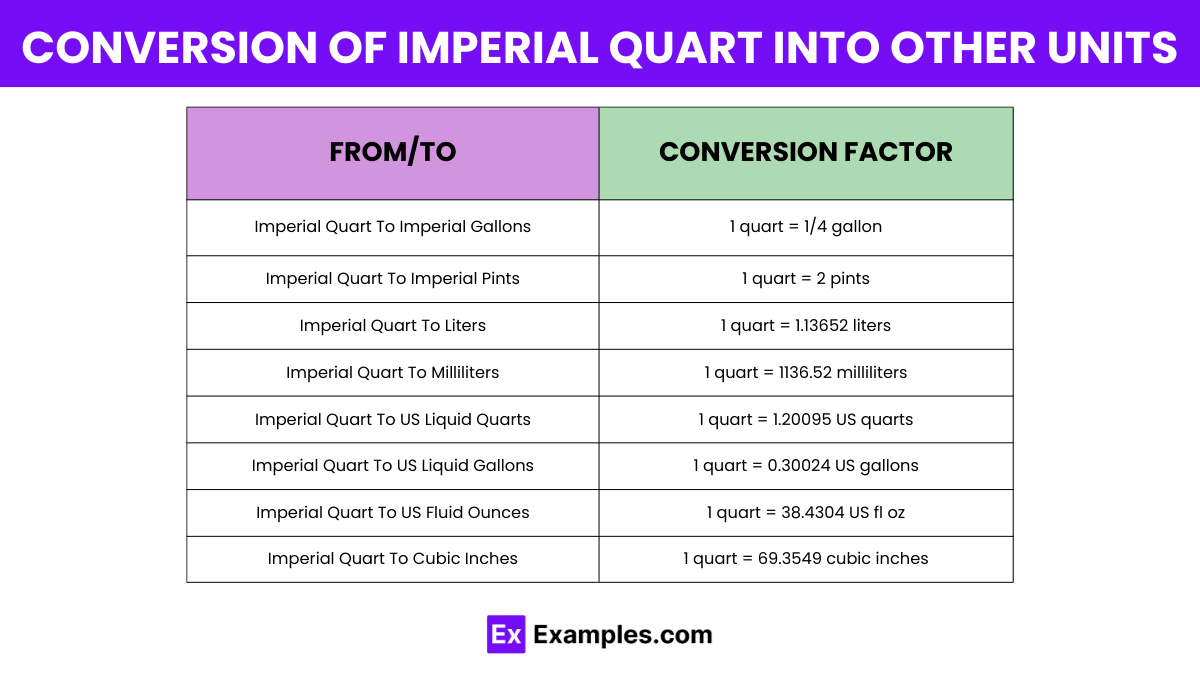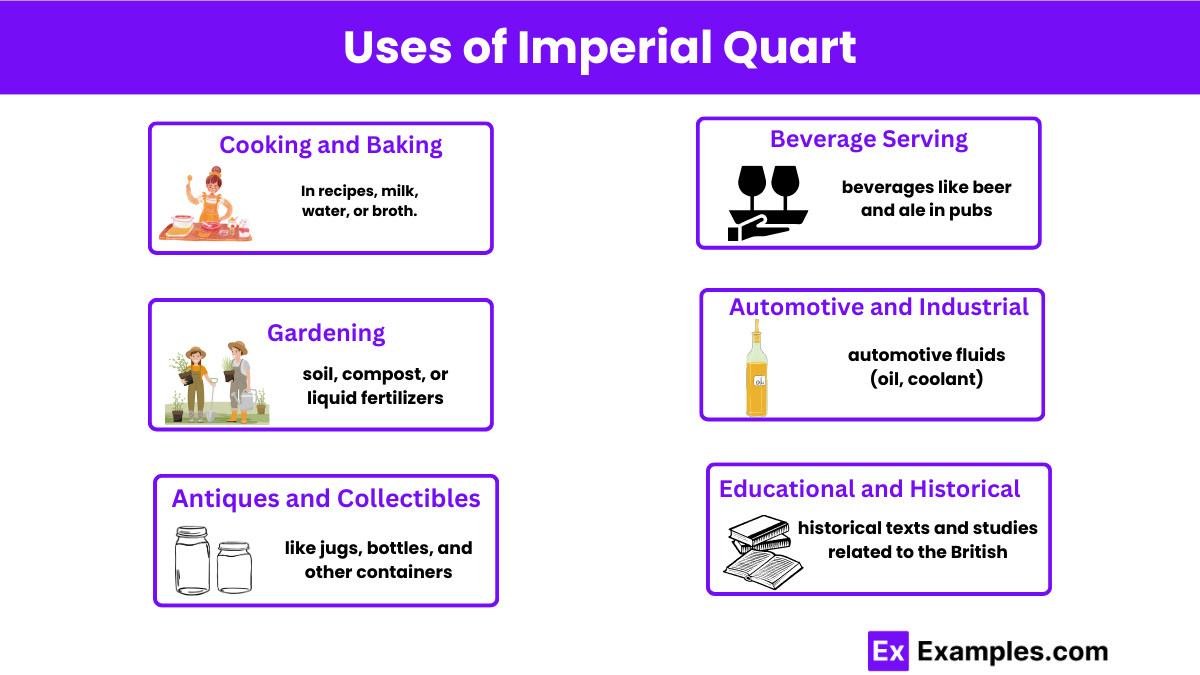How many pints are there in an Imperial quart?
1
2
4
8


This unit is commonly used for measuring liquids such as milk, beer, and other beverages.
The Imperial quart is commonly used in the UK and some Commonwealth countries for various purposes. Here are some examples that illustrate how the Imperial quart is utilized:
Beverages: In traditional British pubs, beer may be referred to in quarts, though it is more commonly served in pints. Historically, a quart of beer was a popular size for a single serving.
Cooking: Recipes, especially older or traditional British recipes, might use quarts to measure liquids such as water, milk, or stock. Modern recipes tend to use liters, but quarts are still seen in some traditional settings.
Gardening: In the UK, gardeners might purchase soil or compost measured in Imperial quarts, particularly when dealing with smaller quantities suitable for potted plants.
Automotive Fluids: The Imperial quart can be used in the automotive industry in the UK for measuring fluids such as engine oil or coolant.
Historical Context: In historical documents, recipes, and science texts, the Imperial quart was frequently used as a unit of measurement, providing insight into the quantities and methods used in the past.
These examples showcase the Imperial quart’s varied applications in daily life and specialized fields, demonstrating its ongoing relevance in certain contexts despite the widespread adoption of metric units.

| From Unit | To Unit | Conversion Formula |
|---|---|---|
| Imperial Quart | Imperial Gallons | 1 quart = 1/4 gallon |
| Imperial Quart | Imperial Pints | 1 quart = 2 pints |
| Imperial Quart | Liters | 1 quart = 1.13652 liters |
| Imperial Quart | Milliliters | 1 quart = 1136.52 milliliters |
| Imperial Quart | US Liquid Quarts | 1 quart = 1.20095 US quarts |
| Imperial Quart | US Liquid Gallons | 1 quart = 0.30024 US gallons |
| Imperial Quart | US Fluid Ounces | 1 quart = 38.4304 US fl oz |
| Imperial Quart | Cubic Inches | 1 quart = 69.3549 cubic inches |
Here’s a list of conversion formulas involving the Imperial quart, which can be useful for converting between different units of volume:
1 Imperial quart is equal to 1/4 of an Imperial gallon.
1 Imperial quart is equal to 2 Imperial pints.
1 Imperial quart is approximately equal to 1.13652 liters.
1 Imperial quart is approximately equal to 1136.52 milliliters.
1 Imperial quart is approximately equal to 1.20095 US liquid quarts.
1 Imperial quart is approximately equal to 0.30024 US liquid gallons.
1 Imperial quart is approximately equal to 38.4304 US fluid ounces.
1 Imperial quart is approximately equal to 69.3549 cubic inches.
The US Liquid Quart and the Imperial Quart are both units of volume but they differ in size and usage, primarily due to the distinct measurement systems they belong to—the US customary system and the British Imperial system respectively. Here’s a breakdown of the key differences:
| Aspect | US Liquid Quart | Imperial Quart |
|---|---|---|
| Volume | Approximately 946.353 milliliters | Approximately 1136.52 milliliters |
| Measurement System | US customary system | British Imperial system |
| Conversion Factor | 1 Imperial quart ≈ 0.832674 US quarts | 1 US liquid quart ≈ 1.20095 Imperial quarts |
| Usage | Commonly used in the United States for cooking, serving beverages, etc. | Historically used in the UK, less common today |
| Cultural Significance | Deeply ingrained in American culture, commonly referenced in recipes and everyday conversation | Reflects historical heritage in the UK and other Commonwealth countries |
These differences highlight how volume measurements can vary significantly between two systems, impacting everything from cooking recipes to industrial usage depending on the country.

The Imperial quart, although less commonly used today due to the widespread adoption of the metric system, still finds its uses in various contexts, particularly in the United Kingdom and other regions where the British Imperial system has historical roots. Here are some of the primary uses of the Imperial quart:
1.Cooking and Baking: In recipes, particularly older ones or those that reference traditional British cooking, the Imperial quart may be used to measure liquids such as milk, water, or broth.
2.Beverage Serving: Historically, beverages like beer and ale in pubs were sometimes served in quarts. Although more commonly served in pints today, the quart remains a part of British cultural references.
3.Gardening: For measuring quantities of soil, compost, or liquid fertilizers, the Imperial quart may still be used, especially in informal or home gardening settings.
4.Automotive and Industrial: In industries that still use Imperial measurements, such as in automotive fluids (oil, coolant), the Imperial quart can be used for non-critical measurements.
5.Antiques and Collectibles: Collectors and dealers in antiques might reference the Imperial quart when dealing with older items like jugs, bottles, and other containers that were originally designed to hold specific quart measurements.
6.Educational and Historical Reference: The Imperial quart is used in educational settings to teach students about the history of measurement systems and their evolution. It also appears in historical texts and studies related to the British Empire and its influence.
The quart is part of the Imperial system, not the metric system. There are two main types: the Imperial Quart used in the UK (approximately 1.136 liters) and the US Liquid Quart used in the USA (approximately 0.946 liters).
The seven basic Imperial units include the inch, foot, yard, and mile for length; pound and ounce for weight; and gallon for volume. These units are part of the British Imperial system used for various measurements.
Text prompt
Add Tone
10 Examples of Public speaking
20 Examples of Gas lighting
How many pints are there in an Imperial quart?
1
2
4
8
Which is larger, an Imperial quart or a US quart?
Imperial quart
US quart
They are the same
Cannot be determined
How many Imperial quarts are in a gallon?
2
3
4
5
Convert 3 Imperial quarts to Imperial pints.
3 pints
6 pints
9 pints
12 pints
If a container holds 8 Imperial quarts, how many Imperial gallons does it contain?
1
2
3
4
Which of the following is equivalent to 1 Imperial quart?
0.5 Imperial gallon
4 Imperial cups
1 Imperial pint
2 US quarts
How many milliliters are in an Imperial quart?
946 mL
1136 mL
1000 mL
1200 mL
Convert 5 Imperial quarts to liters.
4.55 liters
5.68 liters
6.35 liters
7.14 liters
What is the volume in Imperial quarts of 18 Imperial pints?
4.5 quarts
6 quarts
9 quarts
12 quarts
If a recipe calls for 2 Imperial quarts of milk, how many Imperial cups should you use?
4 cups
6 cups
8 cups
10 cups
Before you leave, take our quick quiz to enhance your learning!

